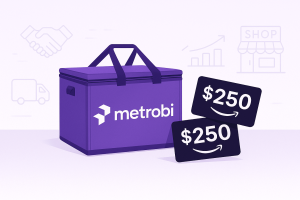Choosing between outsourcing and in-house local delivery can feel like juggling a ticking time bomb.
To grow or not to grow? To scale or not to scale? Ecommerce businesses worldwide face this crossroads, grappling with the immediate consequences and the long-term impacts. This choice isn’t as straightforward as it seems, especially when your business’ success hangs in the balance. Explore how logistics in ecommerce functions as the vital framework supporting businesses in answering these questions, directly influencing their potential for growth and scalability.
In-house vs. outsourcing local ecommerce delivery is the million-dollar question. In this insight-packed guide, we dissect these two options, scrutinizing their strengths and pinpointing their pitfalls. We aim to shed light on the most beneficial choice for your e-commerce operation, empowering you with the knowledge to steer your e-commerce logistics business towards sustainable growth.
Get ready. Your business’ future starts now.
Boost customer satisfaction with just a few clicks
Most-Loved Features:
- On-demand drivers
- Real-time GPS tracking
- Delivery confirmation photos
- Over 50% of customers report a smoother delivery experience
In-depth Analysis: In-house Delivery vs Outsourced Delivery Service for Your Ecommerce Business
Understanding In-house Delivery: Pros and Cons
What is in-house delivery anyway? Breaking it down, it’s the act of fulfilling orders using your assets and personnel. No third parties are involved. But what are the benefits and challenges here?
Definition and Explanation of In-house Delivery
In-house delivery simply means you’re doing it all yourself. You’re handling the entire delivery process using your resources, from the packaging to the shipping and delivery to your customer’s door.
This approach gives businesses full control over their operations and customers directly. However, it’s not all sunshine and rainbows.
Managing the supply chain, local delivery logistics, and the whole order fulfillment process can be a daunting task, especially for small businesses without the necessary resources.

Delivery Makes Up 25% of Online Food Sales:
Off-premise sales, including delivery, comprise 44% of all restaurant sales, with delivery alone making up 25% of these orders.
Benefits of In-house Delivery for Ecommerce Businesses
In-house delivery can offer numerous benefits, such as better control over the delivery process, increased ability to provide a stellar customer experience, and the opportunity to reinforce brand identity through packaging and delivery.
In-House Delivery is More Reliable:
As the world recovered from COVID-19, third-party services took charge of restaurants, denying them vital customer data and imposing fees as high as 30%.
It can help in maintaining customer satisfaction and meeting customer expectations, however, it comes with challenges, including higher overhead costs, extensive logistics planning, and potential liability issues. Not forgetting, scaling up can be quite a hassle in this model.
Challenges of In-house Delivery
One way to overcome these challenges is by using an online store and printing shipping labels online to streamline the fulfillment process. This could help in automating some of the processes and offer a local delivery option. Alternatively, small businesses can also seek the help of local courier services or fulfillment centers to manage local deliveries. To effectively boost your sales, consider enhancing your local e-commerce delivery services by exploring our comprehensive guide on establishing and optimizing your local distribution strategy.
Grasping Outsourced Delivery: Pros and Cons
We’re now moving on to outsourced delivery, which means having a third party handle the delivery process. Let’s walk through what this involves and its associated pros and cons.
Outsourcing Local Ecommerce Delivery: Definition and Explanation
Outsourced delivery: the job is handed over to a third party. They take care of the entire delivery process, such as picking, packing, shipping, and delivering your products to customers.
This choice is often associated with lower operational costs and potentially faster delivery times, thanks to the vendor’s existing infrastructure.
Using third-party logistics or a delivery business can also offer more affordable shipping options and shipping discounts. It can also free up teams to focus on core business functions, leaving the fulfillment process in the hands of a fulfillment partner or delivery partner.
Delivery Choices: Restaurant vs. Third-Party:
78% of delivery orders originate directly from the restaurant, with only 22% being routed through third-party delivery services.
Advantages of Outsourcing Local Ecommerce Delivery for Businesses
Outsourced delivery can offer numerous benefits, such as access to fulfillment expertise, the ability to fulfill orders in-house, the capacity to deliver large shipments, and the opportunity to save money on shipping costs. It can also help in managing logistics and warehouse space for inventory storage, especially for growing online retailers. Moreover, outsourcing order fulfillment and using a shipping provider can help businesses expand their sales channels and reach more customers, leading to rapid growth and a competitive advantage in the market. Discover strategies to lower costs in ecommerce shipping and fulfillment, enhancing profitability while continuing to provide superior customer experiences.
Potential Drawbacks of Outsourcing Delivery
However, there are some potential drawbacks to outsourcing delivery, such as lesser control over the delivery process, the risk associated with the reliability of the service provider other shipping providers, and the potential loss of some brand touchpoints. It’s important to choose a reliable outsourcing partner or shipping provider that can ensure a good customer experience and meet customer expectations. It’s worth noting that drop shipping is also a common form of outsourcing order fulfillment, in which the business owner does not hold inventory but rather purchases products from a supplier who ships them directly to the customer.
Customer Bias: Restaurant vs. Delivery Service:
A majority, or 80%, of customers express their inclination to fault the restaurant rather than the delivery service in the event of any mishaps.
Cost and Operational Efficiency: A Comparative Study
Cost Implications of In-house vs Outsourced Delivery
As an e-commerce business contemplating delivery options, it’s crucial to consider the cost implications.
Detailed supply chain cost comparison between in-house and outsourced delivery
There exists a variety of elements to consider when comparing shipping costs because of in-house and outsourced delivery – labor cost, necessity of equipment, and facility expenditure among others. Having in-house delivery demands investment in an expansive logistics framework, including manpower, vehicles, and warehousing. Whereas, outsourced delivery can offer warehouse space, shipping orders, and fulfillment solutions without the hefty price tag. Using third-party delivery, like the United States Postal Service or the United Parcel Service, can offer affordable shipping options and more affordable shipping discounts.
🚚 In-House vs. Third-Party Delivery: A Cost Comparison 💸
When using a third-party service, a restaurant made $1,042.63 but kept only 36% of it. Switching to in-house delivery, the same sales soared to a 90% profit margin!
Factors influencing the cost in both scenarios
Several factors could escalate the costs in both scenarios – fuel prices, changes in labor laws, toll prices, vehicle maintenance, and technology upgrades. For in-house delivery, the added burden of administration, regulatory compliance, and market volatility could inch up costs. Meanwhile, outsourced delivery might suffer due to poor negotiation terms major carriers, hidden costs, or increases in service provider fees. Discover how these variables impact your local delivery pricing by using our intuitive calculator to receive an immediate estimate tailored to your needs.
Operational Efficiency of In-house vs Outsourced Delivery
Another key factor to consider is the operational efficiency. Managing the fulfillment process and local deliveries can be time-consuming and resource-intensive, affecting small business operations. On the other hand, outsourcing delivery can help businesses focus on their core competencies while leveraging the expertise of a shipping provider or fulfillment provider. Using automated processes and technology can also help in managing logistics and improving the customer experience. A packaging dashboard can help in keeping track of shipping methods and delivery timelines, and in ensuring that the packaging is up to par with customer expectations.
Delivery Fee Subscription:
Of those who use third-party delivery services, 67% express readiness to subscribe to a monthly fee, averaging $15, to eliminate delivery charges for all their orders.
Analysis of operational efficiency in both in-house and outsourced delivery services
Operational efficiency of in-house delivery can be measured by the accurate and timely delivery, control over logistics, and the level of direct customer interaction. In contrast, for outsourced delivery, efficiency manifests as limited management intervention, extended reach, and 24/7 deliveries. Regardless, both options call for relentless analysis centered on specific business needs and customers’ demands.
Delivery Will Constitute a Larger Share of the Market:
Analysts predict that delivery could potentially surpass 40% of all restaurant sales in the future.
Impact on business operations and logistics
Choosing between in-house and outsourced delivery can influence business operations. With in-house delivery, logistics management can be streamlined, but at the risk of overburdening teams with non-core tasks. Outsourced delivery, can liberate resources to shift focus on core workings, but may surrender control of delivery timeline and customer experience. Hence, the trick is to balance business interests and customer expectations.
At the end of the day, the balance between cost-saving and operational efficiency largely depends on the unique context of your business—its scale, budget, and long-term strategy.
Customer Satisfaction: A Key Determinant in Your Choice
How In-house Delivery Impacts Customer Satisfaction
In-house delivery gives your E-commerce business a greater amount of control. Ensuring that your customers receive products on time and in excellent condition plays a crucial role in enhancing customer satisfaction. A stellar in-house delivery mechanism can set you apart from your competition by providing a personalized touch.
Shift from Carryout to Delivery:
21% of consumers are progressively substituting carryout orders with delivery, and among individuals aged 18 to 34, that figure rises to 30%.
However, managing in-house delivery isn’t without its challenges. Delivering to far-off regions or during peak sales periods might put excessive strain on your resources. Mistakes in delivery can lead to reduced customer satisfaction and potential damage to your brand reputation.
Role of in-house delivery in enhancing customer satisfaction
Seamless delivery is integral to creating a delightful E-commerce experience for your customers. In-house delivery provides the flexibility and the power to make necessary adjustments in the delivery process to ensure a positive customer experience. Understanding how a shipment packing list can become a pivotal component will enhance your in-house delivery’s efficiency and accuracy, solidifying customer satisfaction.
Potential issues and their impact on customer satisfaction
Not all sails will be smooth with in-house delivery. An unexpected surge in orders or unforeseen circumstances can cause delivery delays. Similarly, quality issues can arise due to lax handling of packages. These hurdles directly impact customer satisfaction and can diminish their trust in your brand.
The Role of Outsourced Delivery in Customer Satisfaction
Delivery is not just about getting an order from point A to point B; it’s a significant part of a buyer’s overall experience with your brand. That’s where outsourcing your delivery comes into play – it gives you the leverage of professional experience and wide geographical coverage, thus improving customer satisfaction. Comprehend the distinction between delivery and shipping to further enhance your strategy for outsourcing your delivery processes, ensuring a positive impact on your brand’s customer satisfaction rates.
Expanded Choices, Increased Third-Party Usage:
35% of consumers are opting for a broader range of food choices when ordering delivery, a noticeable increase from two years ago. Additionally, 22% are utilizing third-party delivery services more frequently than they previously did.
How outsourcing delivery can improve customer satisfaction
Outsourcing delivery to professionals can improve multiple aspects of the customer experience, including faster delivery times, better tracking facilities, and well-handled packaging. These subtle enhancements contribute to higher customer satisfaction levels.
Weekly Dining Trends: Takeout & Delivery:
60% of American consumers indulge in takeout or delivery services at least once per week. And, 31% of American consumers utilize third-party food delivery services at least twice weekly.
Potential issues and their impact on customer satisfaction
While outsourcing speeds up your delivery process and covers more geographical locations, it may lead to some bottlenecks. Since you relinquish control, it can compromise the personal touch in your delivery and even lead to inconsistencies in service. Any negative experiences can reflect poorly on your brand and hurt customer satisfaction. It’s essential to partner with a reliable and experienced outsourced delivery service provider to minimize these issues.
Collision of customer satisfaction with your choice between in-house and outsourced delivery is inevitable – and crucial. Correct choices can aid in escalating your brand toward growth and trustworthiness.
Making the Right Choice: Factors to Consider
Understanding Your Business Needs
Your choice between outsourcing or in-house delivery should align with your business needs and goals; it’s not a mere follow-up decision. Consider your business size, delivery volume, and geographical reach when evaluating these options.
Importance of Aligning Your Choice with Your Business Needs
Running a successful e-commerce business is more than just selling goods or services. It involves creating a system that supports your business model effectively and efficiently. The selection between in-house and outsourced fulfillment delivery is pivotal, and should directly correlate with the overall vision, mission, and strategies of your company.
Factors to Consider: Business Size, Delivery Volume, Geographical Reach
Your business size primarily determines your operational capacity. If you’re just starting small, outsourcing to a third party logistics third-party delivery services would probably make more sense. However, as you scale up and your volume increases, you might benefit from bringing operations in-house. Your geographical reach is another key determinant; localized delivery might work best with an in-house team, while a wider scope might necessitate outsourcing. To assist you in making this crucial decision, we’ve identified the top ecommerce shipping firms that stand out for supporting businesses of all sizes expand their delivery capabilities both locally and globally.
Evaluating Your Resources
Before choosing a delivery method, evaluate your resources across manpower, infrastructure, and technology. Your choice between in-house and outsourced delivery hinges heavily on this assessment.
Assessing Your Resources: Manpower, Infrastructure, Technology
Assessing your resources should paint a clear picture of your current capabilities. Thoughtfully contemplate if you have the manpower to run an in-house delivery system while maintaining quality. Similarly, check if your infrastructure and technology are advanced enough to handle end-to-end delivery management.
How Your Resources Can Influence Your Choice between In-House and Outsourced Delivery
Having ample resources could lean you towards an in-house delivery system, allowing for more direct control. Conversely, insufficient resources might push you to outsource delivery, freeing up your team to focus on core business tasks.
Considering Your Customers’ Expectations
Understanding and meeting your customers’ delivery expectations should significantly influence your choice between in-house and outsourced delivery.
Understanding Your Customers’ Delivery Expectations
E-commerce customers nowadays expect swift and reliable delivery for online shopping. Determine if your customers are willing to wait longer for a personalized touch or if they prefer speedy delivery from a trusted courier. Enhance your return process by adopting effective backward logistics techniques to smoothly handle returns and exchanges.
Speed Matters: Consumer Willingness to Pay for Faster Delivery:
One-third of consumers are willing to pay extra for quicker delivery.
How Meeting These Expectations Can Influence Your Choice
If your customers prioritize speed over personalization, outsourcing may enable you to meet these expectations. However, if personal touches or same-day deliveries are more critical, running an in-house team might be a more prudent decision.
Your Last-Mile Delivery Game Plan
To bring it all home, in-house operations give you full control but stretch your resources thin. Outsourcing, on the other hand, frees up resources but loosens your grasp on the service quality. Discover the critical role of logistics in ecommerce and its impact on balancing in-house efficiency with outsourced flexibility to optimize service quality and resource allocation.
Remember, the delivery experience is the last touchpoint your customers have with your brand, and it could make or break their customer journey.
Reflect on your resources, your customer base, and your long-term business objectives. Can you afford to take on local delivery responsibilities, or does outsourcing seem a more beneficial path?
Revisit your current logistics. Map out your business operations. You might find you’ve already been heavily leaning one way without even realizing it.
What are the current bottlenecks in your delivery process? Could outsourcing solve them, or would build your own network with an in-house team free you from these challenges?
Your e-commerce business deserves an efficient, cost-effective, and customer-centric delivery system. It’s time to make your move. Be bold, be decisive, and above all, keep your customers at the heart of your decision-making. Because your last mile could be their first step towards brand loyalty.














